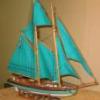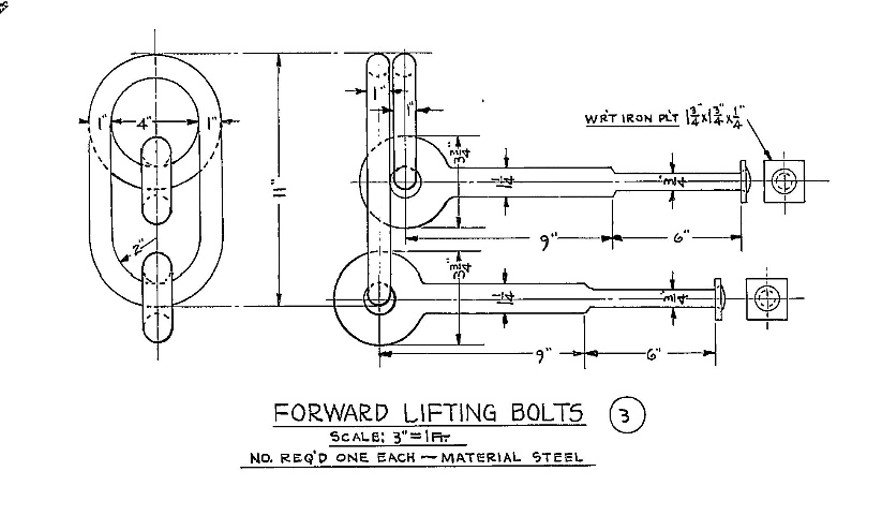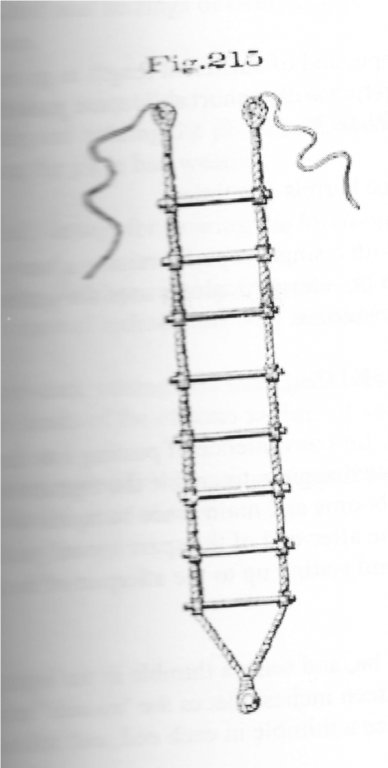-
Posts
2,611 -
Joined
-
Last visited
Content Type
Profiles
Forums
Gallery
Events
Everything posted by JSGerson
-
Pinnace Lower Horizontal Knees After a 10-day break visiting Mom in Florida, who turns 99 years young this coming week by the way, and doing my stuff that should have been done while I was gone when I got back, I resumed my “break neck speed” construction of the pinnace. Using my reduced down to kit size US Navy plans, I made templates for the stern (2 pieces) and bow lower level horizontal knees – a total of three. I could have used the kit plans but the US Navy plans produces a much finer line drawing. These were rubber cemented onto 1/32” bass wood, cut out and fitted into place.
-
Just catching up as I was doing one of my visits to Mom (she turns 99 June 5). I really like your supports on top of the pedestals. I never really liked those simple U-supports (brass or otherwise). They just seemed to me me that they put too much stress on the keel. That added shoulder appeals to my engineer side. I graduated many, many years ago as a civil engineer but never practiced as such. What kind of wood did you use? It looks like walnut.
- 742 replies
-
- constitution
- frigate
-
(and 1 more)
Tagged with:
-
Pinnace Cleats I’ve noticed that some builders have installed the pinnace cleats and others not. The practicum does not. Being the crazy fool that I am, I made the attempt. Using a technique that as far as I know, no one else has used, I made six cleats. The first four images below are from my Rattlesnake build where I needed one very small cleat. The last three from this build. The US Navy plans give the dimensions of two different size cleats, 8’ x 1 7/8” (the other being 6 ¾” x 1 5/8”). At this scale, it won’t make much difference. I chose to base mine on the larger of the two which worked out to be approximately 1/8” x 1/32” at scale. Using some picture hanger nails, ones with a flat head, I filed off two sides of the nail head right up to the nail shank. Then placing modified nail in my rotary tool, I ground it on a file held in a vise. When done, I was left with a very stubby shank just under the modified head followed by a very thin shank. The thin shank is what will anchor the cleat into the wood. Holes were drilled into the rail and the six cleats were then CA’d into place.
-
The thwarts were made from 1/32” boxwood. The mast thwart clamps were made from card stock (file folder) and painted black. I tried using the styrene, but due to the size of the pieces, trying to hold them in place while trying to glue them with CA (PVC couldn’t hold the plastic) was neigh impossible. With the card stock, I could use the PVC and its tackiness would hold the parts in place as I maneuvered their positions. These pictures were taken prior to any staining of the thwarts.
-
To approximate this at scale, I used the smallest ring I had: 1/8”. For the top ring, about a quarter of the circumference of the ring was snipped off and the resulting ends joined together. This reduced the size of the ring closer to scale. The bottom was squeezed to the width of the top ring and resulted in an oblong shape. They were then installed
-
Pinnace Thwarts Continuing my way from the bottom interior up, the thwarts were next. But before I started those, I thought it would be prudent to install the lift fittings double eyebolts at either ends of the boat. Based on the dimension shown on the US Navy plans, 1/16” eyebolts closely approximated the scale needed. Each eyebolt had a ring. The lower eyebolt’s ring was oblong in shape such that it came to the same height as the top eyebolt’s round ring when pulled to the vertical position. The width of both rings were the same.
-
Oh good, another Conny builder I can follow. You've got one more boat under your belt than me so that make you the experienced one (compared to me). I'll be watching with interest as you progress. I decided to warm up to the build by starting on the ship's boats first, so it will be a while before I start the main build. I wish you fair seas and the wind at you back. Jon
-
Pinnace Stern Bench Seat Once more I deviated from the practicum. In this case, the practicum constructed the bench seat from three pieces of boxwood: two side seats and the transom seat. I elected to use one piece of 1/32” plywood because I wanted to use a template I made from the US Navy plans. Interestingly, those plans show the bench as one piece. If the bench in real life was made in multiple pieces, it doesn’t indicate where the seams are. Like the practicum, I did not install any of the underlying support knees or braces. They would have been a lot of work and in the end wouldn’t be seen. Before I made the template, the 3/64” x 1/64” rising was installed about an 1/8” from the top of the rail. It will support the bench seat and the thwarts.
-
The sole then given two coats of diluted white paint; I didn’t want a thick coat of paint. The idea here was that I was hoping the individual planks would be visible after the paint dried. In the end, I still need to enhance the edges around the portable panel with an X-acto blade. Finally, it was fitted into the stern. Another eyebolt with a painted simulate plate was also installed. BTY, I wasn’t concerned that the edges of the sole were not fitted into the sides of the boat model as these will be hidden by the stern bench seat.
-
Pinnace Stern Sole Being a landlubber, I’m was not familiar with boats when I started building these models. So once again, I’m modeling something I have no knowledge about. I’m referring to the aft end on the pinnace, something called the “sole.” This appears to be a floor section of the boat and in this case, one with a portable panel. I’m not certain as to sole’s purpose, but I assume the portable panel is there to gain access to the area below it. The practicum simulates the sole with a piece of styrene etched with lines imitating pieces of wood. I’ve seen others use 1/64” plywood and do the same. I thought I would try something different. Using individual pieces of 1/32” basswood, I reconstructed each piece of the sole as best I could. First a pattern was made based on the plans, but adapted to conform the actual model. This was used to size the pieces and orientate and locate their final position. The problem was that the sole required that the piece be glued edge to edge. This is not structurally strong. To compensate for this lack of mechanical strength, the pieces were PVC glued directly onto paper in five separate groups.
-
Pinnace Bow Footboards These are the short footboards at the bow. According to the Navy plans and the kit’s plans (although you’d be hard pressed to see the detail in their scale size plans), there are four 4 support members that pass over the keelson and supported along the inside walls. From those builders that have posted this detail, including the practicum, nobody has included them in their build. I did, even though you can’t see them when the model finished.
-
The pre-painted beam structures were glued in first using PVC glue so I could make small adjustments. At his point, I decided I didn’t like the copper wire for the bolt. I decided to sacrifice the #80 bit I used to drill the bolt hole as the bolt itself. It was stiff and had the right thickness and color. An eyebolt was required just forward of the step. The eyebolt was not shown a dimension on the Navy plans so I made some measurements off the plans and reduced it scale. It came out to be approximately 1/16”. Because the eyebolt was shown on a metal plate, I painted the bolt and a square area around the bolt black to simulate the metal plate. Finally, the cross structures were added, the two outer “wings”, then a filler piece in the center. A bit of touch up paint, and it was complete. The whole mast step is just ¾” in length.
-
Two of the pieces fit at right angles to the beam pieces and appear to sit on the floor boards. This is where I was confused. The plans state that the two beam pieces fit against the keelson. From the plan view, the cross pieces appear to fir over the beam pieces. The elevation view implies that they butt up against the beam pieces. My best guess is that this structure is constructed somewhat like a grating. Because this was going to be painted and was in a limited view area, I “cheated” and tried to make it look right, not necessarily built right. That license sure comes in handy.
-
Pinnace Mast Step Now that the Pinnace’s interior shell has been completed, the interior structures can now be made. First is the mast step. As usual, my first order of business is to find pictures of the real thing and research how others made theirs. Try as I might, I could not find a single pictures on the internet nor in any of the books on the Constitution I have, nor in any of the books on small boats I have. I did have the Navy plans, but even those were a bit confusing. The practicum skipped this part all together. Of the 34 build logs I have collected, less than five devoted any detail or images as to how they did what they did for the ship’s boats. And of those, nobody followed the kit’s plans which mirrored the Navy plans, meticulously. As usual, just about everyone used artistic license to either skip a lot of details or alter the design for one reason or another. That was their choice and I have no problem with that. My choice is to try and follow the Navy plans as best I can. Using the Navy plans, the four main parts of the mast step were reduced to scale and used as a template. The plans call for a 1 inch bolt to pass through the two beam structures. This would also pass the curved bottom mast so that the mast could pivot along the length of the beam of the boat. A 1 inch bolt reduces to scale of 0.013” or the same as a #80 drill. Any of the images I’ve seen of other builder’s boats, their bolts appear to be thicker. My initial thought was to use some real thin copper wire for this.
-
How the Jacob's Ladder was anchored bugged me, so I did some more digging. I found the following statement in Commodore S. B. Luce, U.S. Navy's Text-book of Seamanship. The Equipping and Handling of Vessels Under Sail or Steam, 1891 pg. 61: "...the lower end [of the Jacob's Ladder] setting up to the afterpart of the crosstrees...and hook into eyebolts placed for that purpose." I realize that the date of the book is almost a 100 years later that the commission of the ship, but I think this would not have changed much. So you are right in using the eyebolts. BTY, this same paragraph in the book also gives a verbal description as to how the ladder is fabricated should you want that.
-
The rail cap was next. The practicum used styrene, I used boxwood. The plastic would have been easier, but is nicer. Also according to the plans, the cap is not painted white. Due to the severe curve of the side rail, this was accomplished with two pieces of 1/32” thick boxwood – one cut to the shape of the bow curve and the other was edge bent after soaking in water for a while. The transom was simply a straight piece of wood.
-
Getting pictures that high up of the masts with any detail is just about impossible for the general public. I did some digging in my book library and I found these drawings in Olof A. Eriken's book, Constitution, All Sails up and Flying. I hope they are what you are looking for. The rope ladders it shows are a little different than yours. Jon Rope Ladders.pdf
-
Pinnace Now I will concentrate on one boat at a time. The pinnace is the first. The plans call for 1/64” thick footlings but don’t specify their width. The US Navy plans show these are 5” x 1” or about 1/16” x 1/64” but the kit does not provide 1/64” wood stock. Using the Byrnes saw and some of the kit wood stock (I forget which size I used), that was easily remedied. I painted the cut pieces first and then glued them into place using 1/32” wide spacers.
About us
Modelshipworld - Advancing Ship Modeling through Research
SSL Secured
Your security is important for us so this Website is SSL-Secured
NRG Mailing Address
Nautical Research Guild
237 South Lincoln Street
Westmont IL, 60559-1917
Model Ship World ® and the MSW logo are Registered Trademarks, and belong to the Nautical Research Guild (United States Patent and Trademark Office: No. 6,929,264 & No. 6,929,274, registered Dec. 20, 2022)
Helpful Links
About the NRG
If you enjoy building ship models that are historically accurate as well as beautiful, then The Nautical Research Guild (NRG) is just right for you.
The Guild is a non-profit educational organization whose mission is to “Advance Ship Modeling Through Research”. We provide support to our members in their efforts to raise the quality of their model ships.
The Nautical Research Guild has published our world-renowned quarterly magazine, The Nautical Research Journal, since 1955. The pages of the Journal are full of articles by accomplished ship modelers who show you how they create those exquisite details on their models, and by maritime historians who show you the correct details to build. The Journal is available in both print and digital editions. Go to the NRG web site (www.thenrg.org) to download a complimentary digital copy of the Journal. The NRG also publishes plan sets, books and compilations of back issues of the Journal and the former Ships in Scale and Model Ship Builder magazines.





